C/2001 Q4 NEAT
The Great Binocular Comet of 2004 no1
Closest to Earth on 6 May 2004 at 0.32AU
Closest to Sun on 16 May 2004 at 0.96AU
Maximum magnitude 2.8 in early May 2004
Orbital Period N/A Parabolic
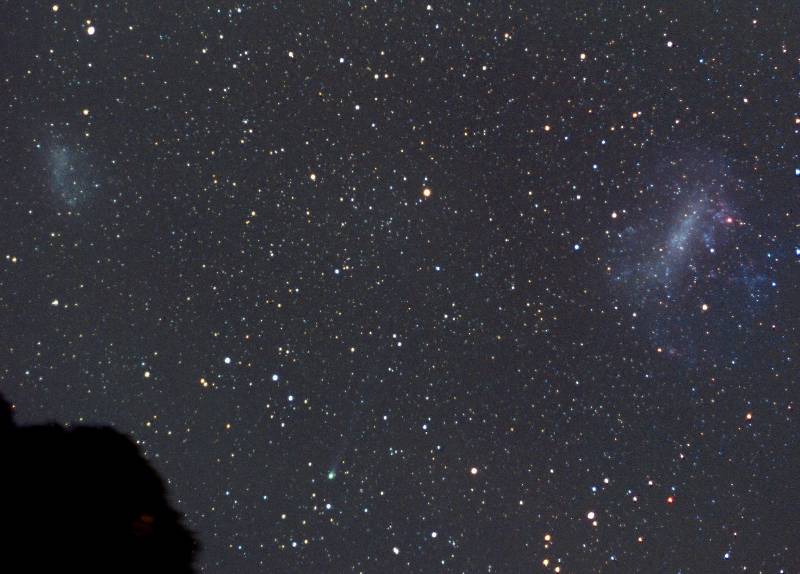
Photo taken 2004 April 17 when comet was situated near the Large and Small
Magellanic Clouds.
C/2001 Q4 NEAT was discovered on 2001 August 21 by the Near Earth Asteroid
Team
at an enormous distance of 10 AU from the Sun (1AU=Earth-Sun distance).
This comet was predominantly a Southern Hemisphere object until May 2004.
Closest approach to the Earth occurred on May 6th 2004 at 0.32 AU (48 million kms).
At this time, the comet peaked
at about magnitude 2.8 and was prominently visible
high in the evening sky for Southern Hemisphere observers in the constellation
of Puppis.
Closest approach to the Sun occurred on May 15th 2004 at 0.96 AU (144 million kms)
when the comet was situated in Cancer,
very close to the beehive cluster M44.
Southern hemisphere observers had a treat from May 18th, when comet C/2002 T7
LINEAR
joined
comet NEAT in the evening sky, and both comets were simultaneously observable with the
unaided eye.
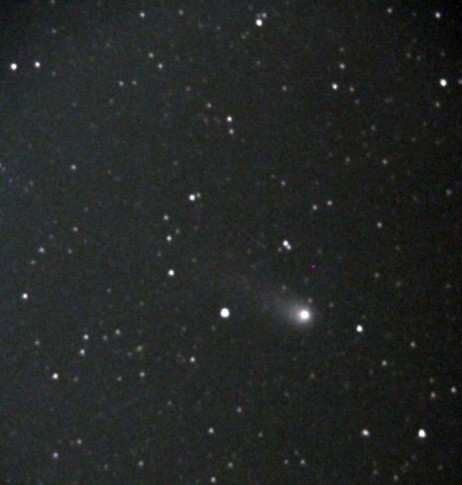
CCD image obtained on 2003 Oct 15th
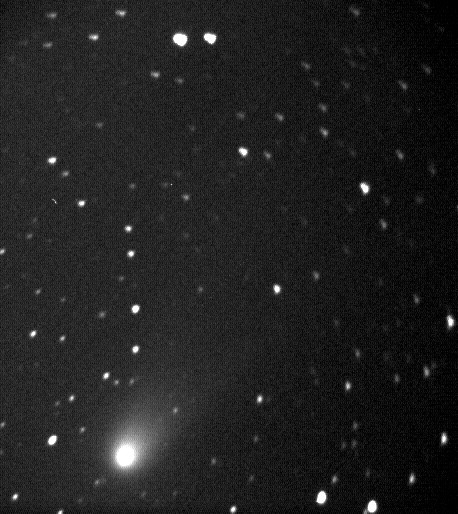
CCD image obtained on 2003 Dec 27th 2003
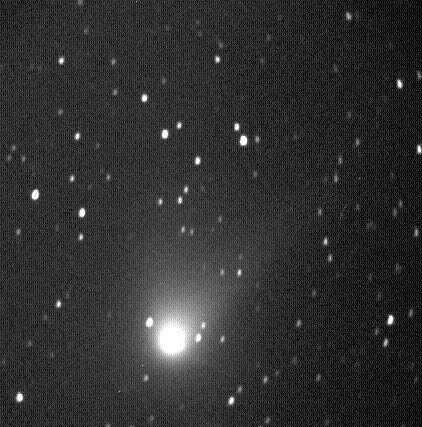
CCD image obtained on 2004 Jan 23rd
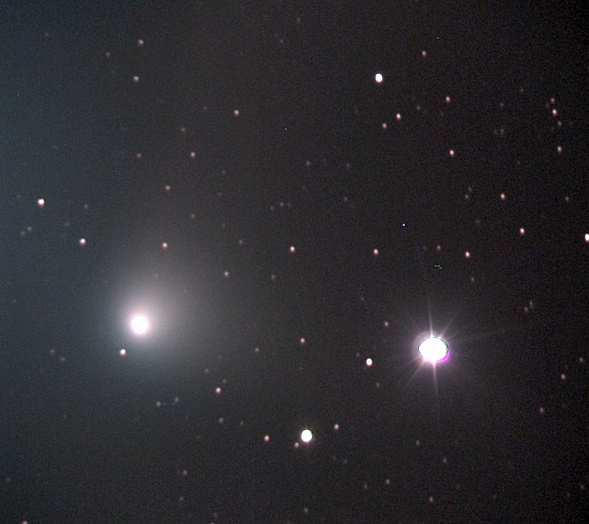
CCD image obtained on 2004 March 12.
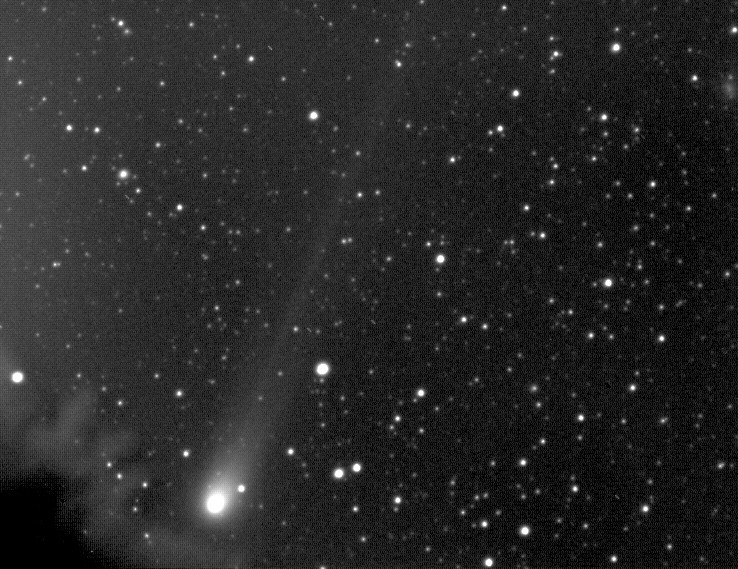
C/2001 Q4 NEAT. Taken on 2004 April 17 at 12:28 UT.
10x30 second exposures through a 135mm Hannimex lens at f/5.6 piggybacked on a
C11.
Field of View 2x2.5 degrees. Note the short broad dust tail and the long
thin ion tail.
Coma size is
12 arcminutes in diameter which translates to 350,000kms across.
Note galaxy NGC 1313 at top right of field.
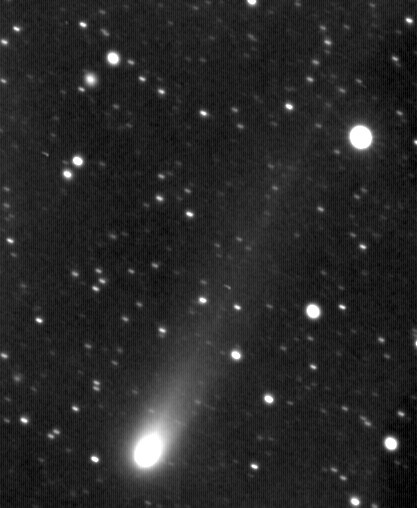
2004 April 20 at 11:05 UT.
30x30 second exposures through a 135mm Hannimex lens at f/5.6.
Field of View 1.8x1.5 degrees. The comet appears edge-on to the
Earth.
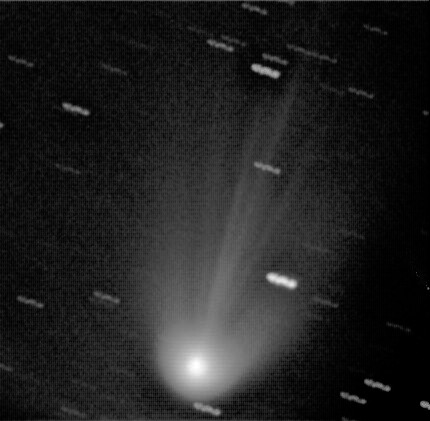

2004 April 20 at 10:40UT.
30x30second exposures taken through a Celestron C11.
Flat fielded and gauss equalised to draw out details around the
nucleus.
Right:
Same photo with the Larsen-Sekania filter applied. This enhances the jets and
shells around the nucleus.
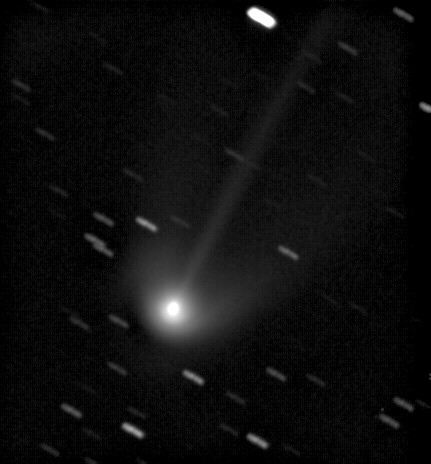
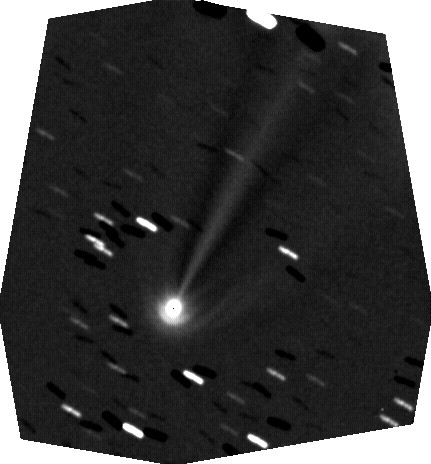
2004 April 21 at 10:15UT.
Left:
27x20second exposures through Celestron C11.
Right:
Same photo with the Larsen-Sekania filter applied.
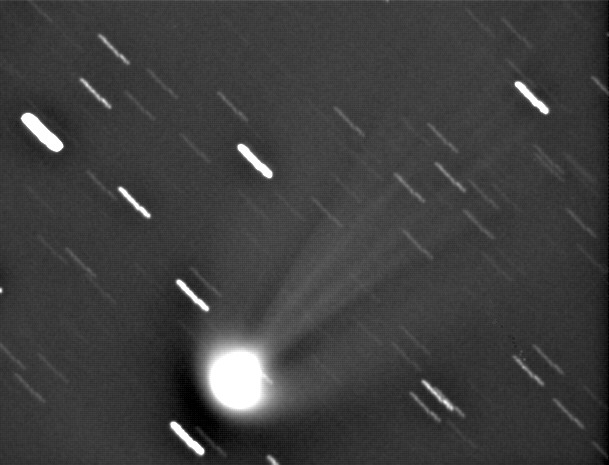
2004 April 26 at 11:20UT.
25x20second exposures, flat fielded
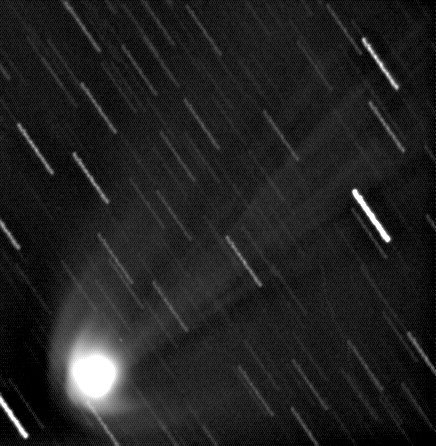
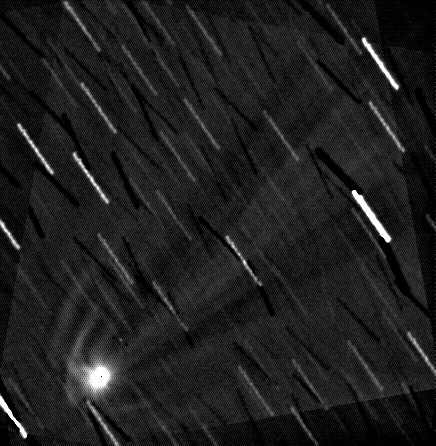
2004 May 4 at 10:32UT.
Left:
30x10 second exposures.
Right: Larsen-Sekania filter applied

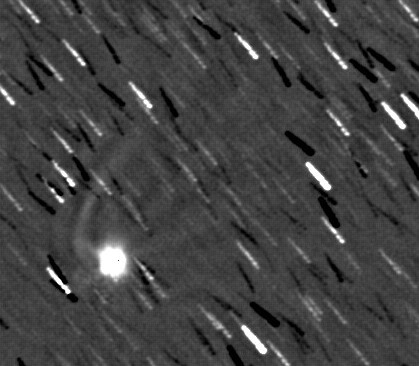
2004 May 6 at 11:50UT.
Left:
13x15 sec exposures through C11 at f/3.3.
Right: Larsen-Sekania filter
applied.

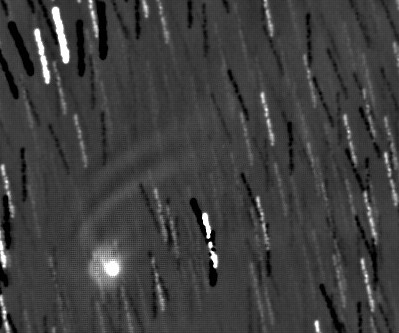
2004 May 7 at 11:10UT.
Left:
15x15 sec exposures through C11 at f/3.3.
Right: Larsen-Sekania filter
applied.
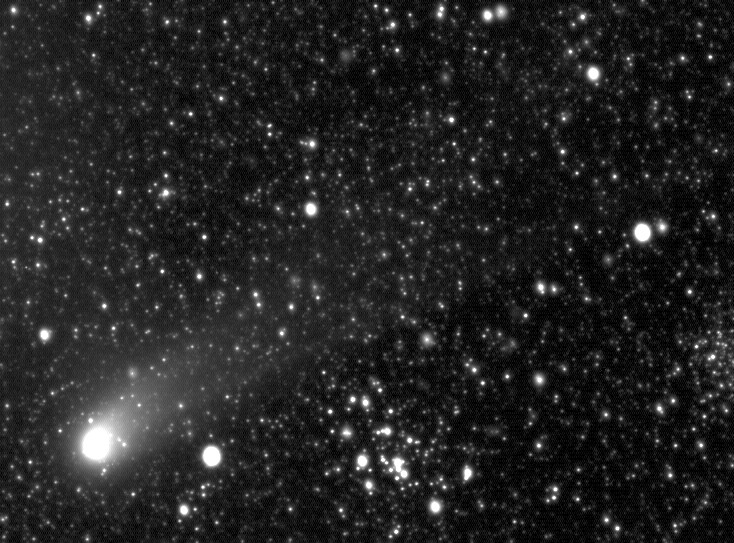
2004 May 7 at 10:20UT.
10x30 second exposures. Field of view 2 degrees wide.
Note star clusters M47 (middle) and M48 (right) in the
field of view.

2004 May 8 at 09:30UT. 10x30second exposures. above.
The bright star to the left of the comet is Alpha Monocerotis.
below is a 30x30second exposures stacked on the comet and unsharp masked to
draw out structure in the tail.
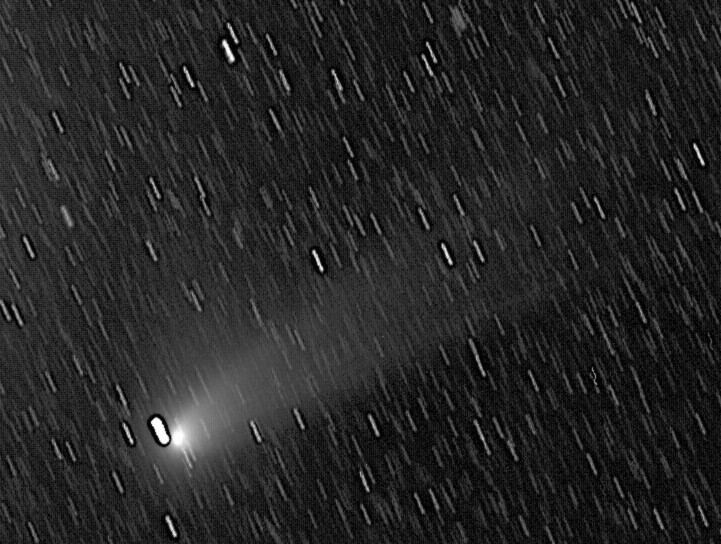
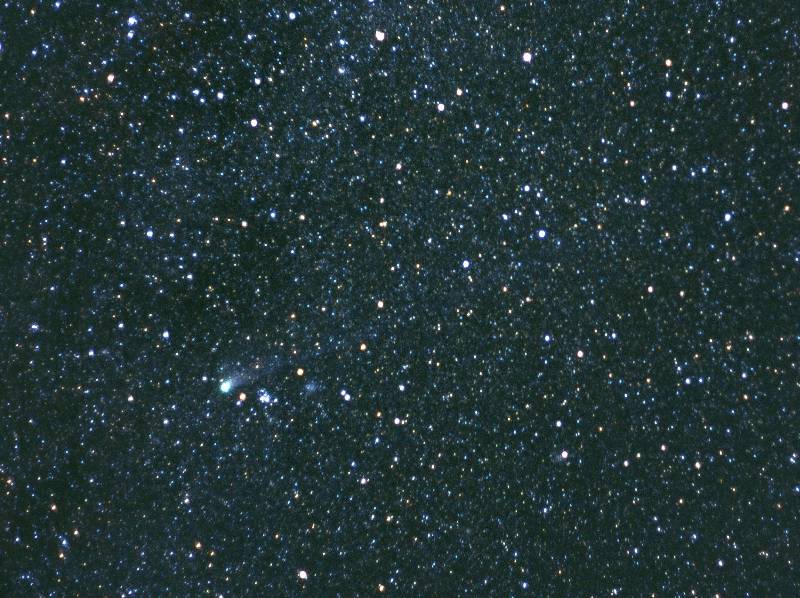
2004 May 07.5UT
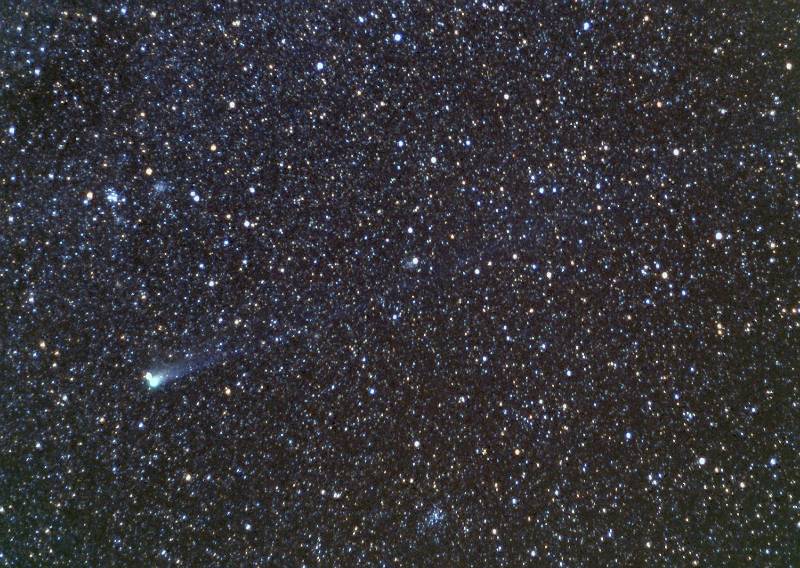
2004 May 08.5UT
Adjacent to Alpha Mon, In 7x50 B ion tail length > 8 degrees. A magnificent
view through 25x100mm B.
Excellent conditions, comet at 50 deg altitude.
Nucleus appears stellar with a triangular shaped dust wave forward of the
core.
Coma appears 25' in size and is blue-green in colour.
A long, faint strand of ion tail is traceable between NGC 2506 and NGC 2539
out to at least 8 degrees.
The rather faint Type II dust tail appears broad with slight curvature
towards the south and is over 2 degrees in length in PA 130.
A very faint type III dust fan spreads in PA 185 along the orbit of the
comet.
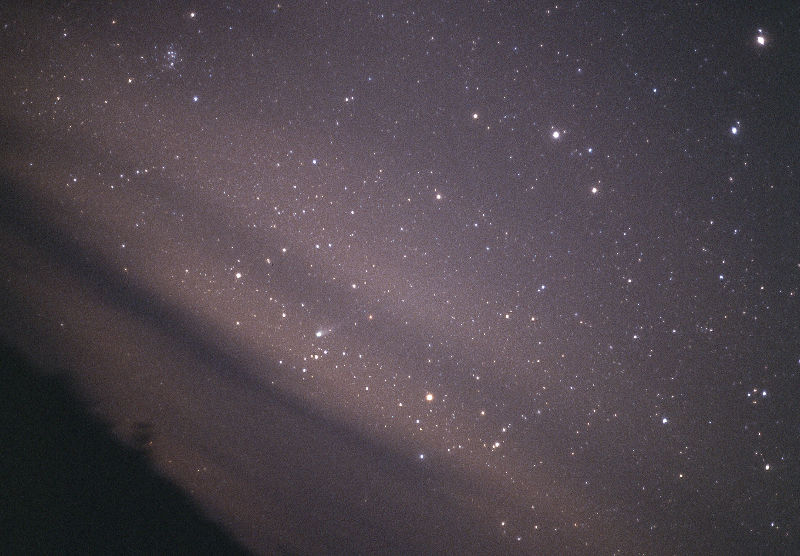
2004 May 20.5UT. Cancer at top left with M44 beehive cluster. Leo at top right
See below a light curve based on my personal observations.
The red curve displays the predicted magnitude from its discovery brightness in
2001. Ho=3.5, n=4
The orange curve is my observed light curve. Ho=5.3, n=3
You can see that the brightness fell short of prediction by nearly 2 magnitudes.
This appears to be NEAT's first and only passage through the inner solar
system.
New comets (non periodic) tend to fall below expectations

My observations in ICQ format below
2001Q4 2002 12 03.56 S 14.5:NO 28 T 6 196 0.3 6 ICQ nn
MAT08
2001Q4 2003 02 01.52 S 15.0:HS 28 T10 133 0.5 5 ICQ nn MAT08
2001Q4 2003 05 29.83 S 14.0:HS 28 T10 310 0.5 5 ICQ nn MAT08
2001Q4 2003 07 22.69 S 13.5 HS 28 T10 133 1.0 5 ICQ nn MAT08
2001Q4 2003 07 22.69 S 13.0 GA 28 T10 133 1.0 5 ICQ nn MAT08
2001Q4 2003 07 27.71 S 12.9 TK 28 T10 133 1.0 5 ICQ nn MAT08
2001Q4 2003 09 18.58 S 12.1 TK 28 T10 133 1.0 5 ICQ nn MAT08
2001Q4 2003 09 21.58 S 12.0 TK 28 T10 133 1.0 5 ICQ nn MAT08
2001Q4 2003 09 27.67 S 11.9 TK 28 T10 133 1.0 6 ICQ nn MAT08
2001Q4 2003 10 13.48 S 11.5 TK 28 T10 133 1.0 6 0.03 312 ICQ nn MAT08
2001Q4 2003 10 16.59 S 11.4 TK 28 T10 133 1.0 6 ICQ nn MAT08
2001Q4 2003 10 22.51 S 11.5 TK 28 T10 133 1.0 6 0.03 330 ICQ nn MAT08
2001Q4 2003 10 29.67 S 11.3 TK 28 T10 133 1.0 6 ICQ nn MAT08
2001Q4 2003 11 11.47 S 11.1 TK 28 T10 133 1.0 6 0.03 0 ICQ nn MAT08
2001Q4 2003 11 14.52 S 11.3 TK 28 T10 133 1.5 6 ICQ nn MAT08
2001Q4 2003 12 13.50 S 10.5:TK 28 T10 133 1 5 ICQ nn MAT08
2001Q4 2003 12 27.52 S 10.1 TK 28 T10 133 2 5 ICQ nn MAT08
2001Q4 2004 01 23.50 S 9.0 TK 10 B 25 3 6 ICQ nn MAT08
2001Q4 2004 02 20.48 S 7.8 TK 5 B 7 5 5 ICQ nn MAT08
2001Q4 2004 02 28.58 S 7.5 TK 5 B 7 5 5 ICQ nn MAT08
2001Q4 2004 03 09.44 S 7.4:TK 10 B 25 5 5 ICQ nn MAT08
2001Q4 2004 03 12.44 S 7.2 TK 10 B 25 6 5 ICQ nn MAT08
2001Q4 2004 03 16.49 S 6.9:TK 10 B 25 6 5 ICQ nn MAT08
2001Q4 2004 03 19.44 S 6.7 TK 10 B 25 7 5 ICQ nn MAT08
2001Q4 2004 03 20.45 S 6.6 TK 5 B 7 7 5 ICQ nn MAT08
2001Q4 2004 03 27.45 S 6.1 TK 5 B 7 7 5 ICQ nn MAT08
2001Q4 2004 04 15.48 S 4.8 TK 5 B 7 11 6 1.8 165 ICQ nn MAT08
2001Q4 2004 04 15.48 S 4.9 TK 0.7 E 1 5 ICQ nn MAT08
2001Q4 2004 04 16.48 S 4.7 TK 5 B 7 11 6 2.0 162 ICQ nn MAT08
2001Q4 2004 04 17.50 S 4.6 TK 5 B 7 12 6 3.0 160 ICQ nn MAT08
2001Q4 2004 04 26.48 S 4.2:TK 5 B 7 13 6 >2.0 140 ICQ nn MAT08
2001Q4 2004 05 01.50 I 3.6 TK 0.7E 1 6 ICQ nn MAT08
2001Q4 2004 05 02.44 I 3.5 TK 0.7E 1 6 ICQ nn MAT08
2001Q4 2004 05 04.46 I 3.4 TK 0.7E 1 6 ICQ nn MAT08
2001Q4 2004 05 06.46 I 3.1 TK 0.7E 1 6 ICQ nn MAT08
2001Q4 2004 05 07.40 I 2.8 TK 0.7E 1 25 6 >3.0 110 ICQ nn MAT08
2001Q4 2004 05 08.44 I 2.8 TK 0.7E 1 25 6 >4.0 110 ICQ nn MAT08
2001Q4 2004 05 10.40 I 3.1 TK 0.7E 1 20 6 ICQ nn MAT08
2001Q4 031213.50 Light pollution moderate [MAT08]
2001Q4 040220.48 In 25x100mm B, a 10' dust? tail is visible in PA 90. Coma
slightly enhanced with a swan band filter.
A CCD image reveals an ion tail >24' long in PA 158 and a small starlike
condensation of 12th magnitude.[MAT08]
2001Q4 040228.58 observed after moonset. 15 degrees elevation [MAT08]
2001Q4 040309.44 moderate light pollution, moderate enhancement with a swan
band filter. [MAT08]
2001Q4 040316.49 moderate light pollution [MAT08]
2001Q4 040319.44 CCD image reveals >30' ion tail in PA 175 [MAT08]
2001Q4 040327.45 In 25x100mm B, >1 degree of tail visible. [MAT08]
2001Q4 040426.48 Moderate light pollution [MAT08]
2001Q4 040501.50 Moonlight 85% [MAT08]
2001Q4 040502.44 Moonlight 92% [MAT08]
2001Q4 040504.46 Moonlight 100%. In 7x50B, coma diameter ~15' with short
tail in PA 120.[MAT08]
2001Q4 040506.46 Moonlight 96% [MAT08]
2001Q4 040507.40 Observation made prior to moonrise. Milky way interference.
A beautiful view through 25x100mm B with star clusters M47/M46 in same field
of view [MAT08]
2001Q4 040508.44 Adjacent to Alpha Mon, In 7x50 B ion tail length > 8
degrees. A magnificent view through 25x100mm B. Excellent conditions, comet
at 50 deg altitude.
Nucleus appears stellar with a triangular shaped dust wave forward of the
core.
Coma appears 25' in size and is blue-green in colour. A long, faint strand
of ion tail is traceable between NGC 2506 and NGC 2539 out to at least 8
degrees.
The rather faint Type II dust tail appears broad with slight curvature
towards the south and is over 2 degrees in length in PA 130.
A very faint type III dust fan spreads in PA 185 along the orbit of the
comet. [MAT08]
2001Q4 040510.40 Faint tail visually. In 25x100mm B, coma diameter is 22'
wide, ion tail is >5 degrees in PA 108, with 2 degree dust tail arching
southward of the ion tail. [MAT08]
























